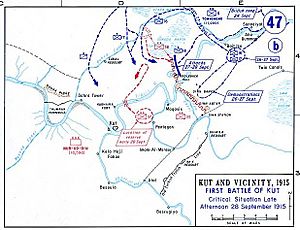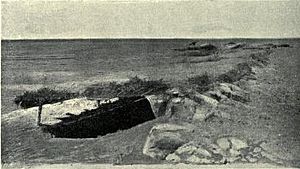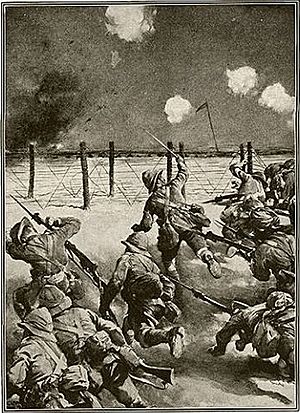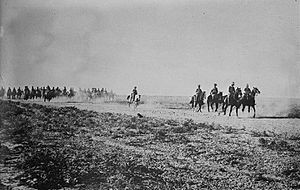Battle of Es Sinn facts for kids
Quick facts for kids Battle of Es Sinn |
|||||||
|---|---|---|---|---|---|---|---|
| Part of the Mesopotamian Campaign of World War I | |||||||
|
|||||||
| Belligerents | |||||||
| Commanders and leaders | |||||||
| Strength | |||||||
| 6th (Poona) Division | 10,500 13 guns |
||||||
| Casualties and losses | |||||||
| unknown | unknown | ||||||
The Battle of Es Sinn was an important fight during World War I. It happened on September 28, 1915. This battle was part of the Mesopotamian Campaign, which took place in what is now Iraq.
The battle was fought between soldiers from the British Empire (including many from British India) and the Ottoman Empire. The main goal was to control the lower parts of the Tigris and Euphrates rivers. Both sides also wanted to see if the British and Indian forces could push further and capture the city of Baghdad.
Major-General Charles Vere Ferrers Townshend led the British and Indian troops. Colonel Nureddin led the Ottoman forces. The battle happened near the town of Kut-al-Amarah. The British and Indian soldiers marched at night and surprised the Ottoman defenders. They won the battle, which allowed them to capture Kut the next day. This gave them control over the important rivers.
Contents
Why the Battle Happened
After the British and Indian forces secured the area around Basra, they debated what to do next. At first, their mission was just to protect the oil pipelines in the region. But their early successes made them think about advancing further.
The British government in London wanted to keep the fighting to a minimum. They mostly cared about protecting Basra and the Shatt al Arab. This was important to make sure oil from Abadan kept flowing to fuel the British Royal Navy.
However, the Indian government in Simla saw things differently. They wanted to show that the British Empire was still strong, especially since the war was tough in other places like Gallipoli. They believed that advancing to Baghdad would make the region safer and show British power.
The British Army officers on the ground also wanted to attack. They thought the Ottoman forces they had already beaten were weak. They also knew that many Ottoman soldiers were unhappy conscripts who didn't want to fight far from home.
Even though London was careful, the Indian government had control over the campaign. They approved the advance. But they were told that no extra soldiers would be sent from other war zones.
Getting Ready for Battle
With approval, Lieutenant General Sir John Nixon and Major-General Townshend planned to capture Kut. The British and Indian forces had grown to about two divisions. This included the 6th (Poona) Division and the 12th Indian Division.
River boats from the Royal Navy and Royal Indian Marine helped the advance. These boats carried supplies and had guns. They were very important because there were no good roads or railways in the area.
By September 11, 1915, Townshend gathered his troops at Ali Gharbi. He had about 11,000 men and 28 artillery guns. They moved along the Tigris River, relying on animals and river boats for transport. However, they didn't have enough supplies or animals to carry everything.
Meanwhile, the Ottoman Sixth Army was getting ready. They were led by Colonel Nureddin, a skilled commander. His army was made up of the 35th and 38th Divisions. These divisions had been weakened in earlier fights. They also didn't have many soldiers, only about 10,000 men and 32 artillery guns. Many of his soldiers were unhappy conscripts.
Nureddin chose to defend a place called Es Sinn. It was a bend in the Tigris River south of Kut. He built strong trenches on both sides of the river. On the north side, his trenches stretched to large marshes, which were like impassable swamps. On the south side, the trenches were on high ground, giving them a good view. He kept some reserve troops five miles upriver, ready to move quickly if needed.
The Battle Begins
On September 27, 1915, Townshend's forces reached the Ottoman positions at Es Sinn. Scouts had found a way around the marshes on the north side. Townshend decided not to attack head-on. Instead, he planned a clever move to surround Nureddin's forces.
He sent a small group to pretend to attack on the right side of the river. The main force crossed to the left side. Then, he split his troops into three groups. Two groups would march around the marshes and attack the Ottoman trenches from behind. The third group would pretend to attack from the front to keep the Ottoman soldiers busy. The cavalry would circle around to block any Ottoman retreat. This whole plan depended on a difficult night march across the desert.
The plan almost failed before it started. Two Indian soldiers deserted and told the Ottomans everything. But Nureddin didn't believe them. He thought the British would only attack along the riverbanks.
The night march began at 2 a.m. on September 28. Things went wrong quickly. One column got lost in a marsh. This delayed the attack by several hours.
Around 8:45 a.m., the British commander, Brigadier General Delamain, decided not to wait any longer. He ordered his column to attack the Ottoman positions. His troops faced strong resistance and suffered many casualties. The 117th Maharattas lost all their British officers.
Unknown to Delamain, the lost column had already stumbled into an Ottoman fort. When they finally arrived, they joined the attack. Eventually, the British and Indian soldiers cleared the Ottoman trenches with bayonets.
As the northern Ottoman defenses fell, Brigadier General Fry tried to turn his fake attack into a real one. But the Ottoman defenders fought hard, and Fry's attack got stuck. Even with help from gunboats on the river, they couldn't break through.
At this point, Nureddin's reserve troops arrived. They tried to take back the Ottoman lines. But the British and Indian soldiers stopped their advance and forced them to retreat.
Meanwhile, Townshend ordered the river boats to push forward. He hoped they could capture the Ottoman boats and the town of Kut. The boats sailed through heavy fire. But just before Kut, they found the river blocked by sunken boats and steel cables. Lieutenant Commander Edgar C. Cookson, the leader of the river boats, tried to cut the cables himself. He was shot and killed. He was later given the Victoria Cross, a very brave award.
By the end of the day, the British and Indian troops had captured most of the northern trenches. Nureddin realized he couldn't hold the position. During the night, the Ottoman forces retreated.
Even though Townshend's cavalry was in position, they didn't attack the retreating Ottomans. They just followed them to Kut. One reason given was that charging would mean leaving behind their cooking equipment. This was a big problem because many Indian soldiers had strict dietary rules and couldn't use local cooking pots.
What Happened Next
Townshend's forces held the battlefield as Nureddin's army retreated north of Kut. Nureddin's army would later stop at Ctesiphon to prepare for another fight.
Townshend's forces entered Kut on September 29, 1915. They had to pause for a few reasons. First, they had reached the limit of their orders. They needed permission to go further. Second, their supplies and medical support were struggling after the battle. These problems would continue to affect the British forces later in the war.
Medical Challenges
The British had planned for only a small number of casualties. But the battle had more wounded soldiers than expected. There weren't enough doctors, hospitals, or ways to transport the wounded. Many injured soldiers had to be carried on simple animal carts, sometimes even on top of ammunition boxes.
River Transport Issues
The British also relied heavily on river transport because land transport was difficult. However, the Tigris River was shallow. As the campaign moved further from Basra, the supply lines became very long. The river also got shallower later in the year, making it hard for many boats to navigate.
Battle's Impact
Nureddin managed to save his army, even though they were beaten. The pause in fighting allowed him to reorganize his troops. New soldiers arrived, and he was able to gather more forces. He learned that his troops fought well when defending from trenches. At Ctesiphon, he would build new trenches and wait for the British.
The British victory at Es Sinn made General Nixon believe that Baghdad would be easy to capture. But Townshend was more cautious.
A big debate started between London, the Indian government, and Nixon. The Indian government wanted to advance, but only if they got more soldiers. Nixon wanted to go to Baghdad at any cost. London strongly disagreed, fearing they couldn't hold Baghdad even if they captured it.
Eventually, the British Prime Minister, H. H. Asquith, got involved. Military leaders warned that the British forces were too small. They knew that many new Ottoman troops would arrive soon. Despite these warnings, the government approved the advance on Baghdad. This led to the Battle of Ctesiphon.
Main Forces in the Battle
Here are some of the main groups of soldiers who fought in the Battle of Es Sinn:
- British and Indian Forces:
- 6th (Poona) Indian Infantry Division
- 6th Indian Cavalry Brigade
- Other smaller units and artillery
- Ottoman Forces:
- 38th Infantry Division
- 35th Infantry Division
- Reserve infantry and cavalry units






